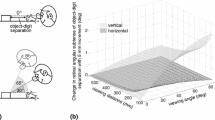Abstract.
It has been observed that wearing goggles that restrict the field of view (FOV) causes familiar objects to appear both smaller and nearer. To investigate this further, we examined the effect of a range of field sizes (4°, 8°, 16°, 32° and 64°) on estimates of object distance and object size used to control reaching and grasping movements of binocular observers. No visual or haptic feedback was available during the experiment. It was found that, as the FOV was decreased, the distance reached by subjects also decreased, whereas the size of their grasp was unaffected. In a second experiment, we compared reaching and grasping responses under binocular and monocular conditions for 8° and 64° field sizes and show that the effects of FOV do not result from the progressive loss of binocular information. We conclude that reducing the FOV produces substantial and dissociable effects on reaching and grasping behaviour and that field size must be taken into account in any context where visuo-motor performance is important.
Similar content being viewed by others
Author information
Authors and Affiliations
Additional information
Electronic Publication
Rights and permissions
About this article
Cite this article
Watt, S., Bradshaw, M. & Rushton, S. Field of view affects reaching, not grasping. Exp Brain Res 135, 411–416 (2000). https://doi.org/10.1007/s002210000545
Received:
Accepted:
Issue Date:
DOI: https://doi.org/10.1007/s002210000545




